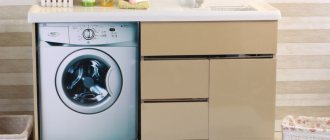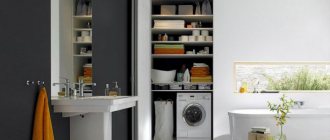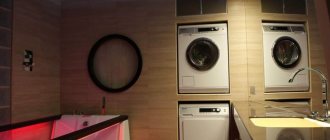Tee in the bathroom.
Tee in the bathroom between the machine mixer. The position of the electrical outlet is also a point that should be taken into account: it is better if it is placed next to the machine. If it is not there, you should consider installing it. The use of an extension cord is not advisable due to the dangerous proximity of water.
Socket next to the washing machine.
Installation methods
It is difficult to place a washing machine in standard sets. To solve this problem, it is better to choose a custom-made kitchen option.
Washing machine and refrigerator 6 sq. m.
The washing machine occupies the space under the dining tabletop, and the refrigerator is built into the cabinet. Thus, for 6 square meters. m. managed to combine maximum functions.
The window sill was replaced by kitchen furniture. This method allows you to save space in the room and accommodate all the necessary modules.
It is advisable that the washing machine and other built-in appliances be separated by one or two cabinets. Such insulation is necessary for the correct operation of devices.
If this option is not possible, arrange high-quality thermal insulation inside the module.
A freestanding refrigerator is located on the opposite wall from the unit, next to the compact dining table. Drawers separate the kitchen stove from the module to which the water supply system is connected. This approach allows you to comply with safety rules during the operation of devices.
Models hidden by countertops and facades
Household appliances are hidden by doors.
Dishwasher, washing machine, hob, refrigerator and freezer. The lower tier of furniture is filled with electrical appliances.
The floor at the installation site should be reinforced with plywood (for reliability). This will eliminate the unevenness of the base (adjusting the supports does not always solve this problem).
Take into account the vibration of the device during spin mode. For correct operation, it is necessary to make a gap - about 2 cm on each side. Vibration becomes more noticeable at minimum load.
The doors cover the washing machine and dishwasher.
Modern corner set.
The washing machine was installed in the leftmost module, next to the kitchen sink.
Video
Undercounter washing machines without doors
In this 8-meter kitchen, the machine is not covered by the façade. However, the modern design looks appropriate in a laconic set. In addition, the surface of the metallic shade is in harmony with the coating of the refrigerator.
For visual unity, the facade can be covered with a special film or painted in the color of the set. Some companies decorate household appliances according to individual preferences.
Minimalism in the kitchen interior.
U-shaped headset layout. The distance between the modules must be at least a meter for comfortable use of the kitchen.
Laundry room and corridor
It is best to provide a separate room for washing - a laundry room. The laundry room can be allocated during redevelopment, but it is important to do this correctly so that the redevelopment is legal.
The standards allow you to expand or organize wet areas in the non-residential part of the apartment. The non-residential part includes corridors and storage rooms.
You can use a corridor or organize a laundry room in the storage room - the most important thing is that there is access to water and sewerage connections.
Be sure to provide an exhaust hood in the laundry room - this is necessary to remove exhaust moist air.
It is possible to install a washing machine in the hallway, for example, hide it in a closet and organize a place for collecting laundry there.
What to pay attention to
Sometimes the corridor really becomes the last option where you can put the typewriter. Otherwise, you will have to do without it altogether or carry things to the laundry and dry cleaning all the time.
Weekly washing of clothes in the laundry will become expensive, so you will have to put the machine in the hallway.
It is quite possible to install the machine in the corridor, but to do this you need to consider the following:
- the area of the corridor, whether there is any space in it, whether the car will interfere when entering the apartment or when opening the door to the room;
- how far the machine will be from the sewerage system and water supply;
Connecting a washing machine
The nuances of connecting a washing machine in the hallway consist mainly of how to hide the hoses running from the machine to the drain and water supply. If the machine will stand through the wall with the bathroom, then in this case it will be easier to connect it and hide the communications. You can run the hoses through a hole in the wall.
It’s a completely different matter if the machine is on the opposite side of the bathroom. In this case, the hoses running across the entire corridor will obviously get in the way; you won’t want to trip over them every day. The only possible solution is to hide communications in the floor.
To connect the washing machine you need to buy a long drain and inlet hoses. Do not connect short hoses, this risks water leakage. As we have already noted, a long hose affects the operation of the drain pump. But in many ways everything will depend on the brand of washing machine. In most models it is not recommended to exceed the hose length by 3 m,
whereas in Zanussi washing machines, this figure is higher, since these machines have a more powerful drain motor.
How to hide equipment
All that remains is to talk about how to hide the equipment, how to install it so that no one sees the unit, and so that it does not interfere with anyone. Even in such a small room as a corridor or hallway, there are different ideas for the location of the machine.
In the photo below, the washing machine is hidden in a closet; it can be a cabinet under the washing machine, or a large pencil case with additional shelves on top for household chemicals.
Here is another option for placing the machine - behind sliding doors or in a closet. It’s very convenient, because you can make hangers for clothes or shelves for household chemicals and other things nearby.
If you still don’t want to hide the machine, it may look like the photo below. On the one hand, it is not aesthetically pleasing, but on the other hand, nothing prevents you from opening the drum and cuvette a little so that the machine is ventilated and no odors appear in it.
Some people hide the washing machine behind a curtain, for example, as shown in the photo below. Curtains are selected in accordance with the style of the room. You can hang them either on a rod fixed between the walls or on a ceiling cornice.
So, the washing machine is placed in the hallway, but very rarely. This option is chosen only if there is limited space in the kitchen or bathroom, or if communications are close to the corridor. Therefore, before installing your car like this, think carefully.
It's a rare housewife who can do without a washing machine. Many different modifications of this assistant are available. It is more common to place it in the bathroom or kitchen. But it happens that the dimensions of these rooms do not allow even the narrowest model to be placed there. An unexpected and convenient option may then be a washing machine in a closet in the hallway, which does not take up space in a small bathroom or kitchen and is hidden from prying eyes behind a furniture facade.
Washing machine in a closet in a narrow corridor.
This arrangement solves several problems at once: it does not change the style of the interior, saves space, and soundproofs equipment. But in order to properly connect the washing machine and aesthetically fit it into the interior, you should think through the entire process down to the smallest detail.
A machine that fits aesthetically into the interior.
Having decided that a washing machine in the hallway is the only possible option, you should take into account the features of its placement:
The area of the room and its shape. If the size of the hallway allows, you can arrange a laundry room in the closet, where you can place an additional drying machine, laundry basket, and cleaning products. For more modest possibilities, use a corner or niche to build a closet there.
Cars hidden behind a hinged cabinet.
Location of water supply and sewerage. The more distant the communications, the greater the likelihood of washing equipment failure due to the load on the pump.
Place the washing machine close to a drain.
Nuances of self-assembly
You will choose what to make the cabinet above the washing machine from and what design decisions to follow. I'll just give you just a few recommendations.
Be sure to draw up preliminary drawings and assemble the cabinet strictly according to them. You shouldn’t do everything by eye or simply copy other people’s designs that you like. Everyone has different bathrooms, different free space and the corresponding dimensions of the washing machine itself.
But according to generally accepted rules, the width of the cabinet should be 3-4 centimeters greater than the width of the machine.
As for height, there are no strict restrictions. You can make it at least 1.5, at least 3 meters. But keep in mind the fact that tall structures are less stable. But this way you will be able to get more shelves and drawers. Look for a reasonable middle ground. Most often, cabinets up to 2.5 meters high are used.
Make a cabinet based on the size of the bathroom. If you assemble a huge cabinet and insert it into a small bathroom, it will look ridiculous. Plus it will require a lot of space.
I think that after considering all these nuances and features, you can safely go to a furniture store, or write a list to visit the construction market, where you will purchase all the necessary materials.
I’ll add on my own behalf that the cabinet above the washing machine is really a good solution, which I personally and my family have been using for several years. And no one is going to give it up.
Thanks to everyone who visits and reads us! Don't forget to subscribe, leave comments and ask relevant questions! We are always happy to communicate with our readers!
Watch this video on YouTube
How to disguise a washing machine in the hallway
It is important not only to install this household appliance in the hallway, but also to successfully hide it from prying eyes. To do this, it is proposed to use one of the options:
- If there is a niche in your hallway, you can install a washing machine in it. When creating a separate niche for a machine, it is recommended to draw up a floor plan taking into account the size of the washing machine, model and everything that is supposed to be placed nearby - shelves for washing powders, a drying device;
- install the machine in a cabinet - wall-mounted, floor-mounted or built-in. Cabinets are made in the form of cabinets or narrow pencil cases, for which various materials are used. You can make a whole closet in the form of a compartment, providing a system of shelves inside for everything you need for washing clothes;
- if the size of the hallway is limited, install a washing machine and hide it behind a regular curtain. The curtain must be chosen to match the overall style of the hallway.
Internal filling
An important point is also the internal layout of the cabinet. After all, it will be filled not only by the washing machine, but also by other items, as well as household chemicals
For example, if in addition to the washing unit, there will also be a dryer, then it is important to create a space between them in the form of a free section. Do not put one car on top of another or move them close to each other
You need to think about how many and what kind of shelves you will need for powder, conditioner, bleach, stain removers, and so on. With shelves, cabinets become much more spacious. A laundry basket also requires space, because you will have to put a large volume of dirty things into it, which do not always immediately fit into the drum of the machine. It is worth considering that sometimes things will emit an unpleasant odor. By choosing the right place for things in the closet, unpleasant moments like mold can be easily avoided.
With a small number of shelves, it is very convenient to use hanging baskets. Particularly interesting are the options with perforation, wicker or mesh.
And it doesn’t matter at all what material they are made of.
A wave-shaped towel holder can be a convenient addition. Its grooves are great for storing folded towels. A rod is suitable for hanging towels. As a result, you will not have to allocate a special place for drying them. If you have limited space, use hooks or clips.
Installation options
Let's figure out how to hide the equipment and build it in so that it does not catch the eye and does not clutter up the apartment. Thanks to the entrepreneurial spirit and imagination of designers, there are a lot of ideas that will tell you how to install the machine, making it unnoticeable.
Option 1. Wardrobe
This washing machine is hidden in the closet. Instead of a cabinet, you can use a cabinet or a pencil case with shelves for detergents.
Option 2. Door
How to install a machine so that it is not visible at all? Make a sliding door, like in a wardrobe, and no one will guess that behind the beautiful door there is a powerful electrical appliance. Saving space is as convenient as it is convenient - you can place hangers nearby or hang shelves for detergents.
Option 3. Angle
If the task is not to hide the equipment, but simply to place it where it is convenient, the photo below shows such an option. There is little aesthetics in it, but it will be convenient to use the device.
Option 4. Curtain
A budget-friendly, but no less interesting way is a curtain. Today, the choice of textiles is so wide that you can choose decent options that will harmoniously fit into the interior and hide your “helper”. For fastening, use a special rod or cornice.
Is it possible to install SMA in the hallway? And in the corridor? Of course you can! The main thing is to ensure that it is connected correctly and make sure that it does not distort the interior design. The connection details will be discussed below.
The main “headache” is how to hide the hoses and tubes. If there is a kitchen or bathroom behind the wall near the SM, there will be no problems. But, if the washing machine is installed on the opposite side, how to connect it so that nothing interferes?
There is only one way out - to hide communications in the floor. But this is already the task of the repairman. We will tell you about the classic connection method:
Buy extended hoses for draining and taking water. Avoid docking, otherwise the risk of leaks will be high. It is advisable not to use hoses longer than 3 m.
When connecting to a water supply, you can go in three ways:
If you have a separate water pipe outlet in the wall, you can connect the drain hose there through a tap.
After connecting the “water” communications, take care of the electricity. The closer the outlet is to the car, the better. If there is no suitable outlet nearby, study the "" page.
Let's summarize: a washing machine is rarely placed in the hallway, but if you plan everything correctly and connect the device correctly, no difficulties are foreseen.
It often happens that the size and layout of the kitchen do not allow installing a full-fledged refrigerator there. But the whole kitchen revolves around him! Yes, and you want the room to be beautiful, make a good impression, be comfortable and functional. What to do if the kitchen size is only 5 m2?
With this solution you can easily create a comfortable and functional interior.
Ways to place the refrigerator:
- If there is a small pantry next to the kitchen, the refrigerator can be placed there;
- Disguising the refrigerator as a cabinet in the hallway or corridor;
- Combining a kitchen with a loggia.
One of the most acceptable and less expensive options is to place a refrigerator in the hallway. Yes, at first it seems a little unusual, but over time you will see that it is convenient. In addition, the choice is small when you have to choose between appliances that should be placed in the kitchen: an oven or a refrigerator.
Ways to place a refrigerator in the hallway:
- In a special cabinet, which was made to order;
- In the corridor niche;
- In a small hallway closet.
Placing a refrigerator in a closet has a number of advantages: a significant amount of space is freed up in the kitchen, there is a lot of light, the built-in refrigerator will not disturb anyone. At the same time, the cabinet will continue to perform all its functions. You need to personally decide what kind of cabinet design you want to see in your home.
Universal kitchen
The washing machine requires connection to water and sewerage. Utility lines run in the wet areas of the apartment, so placing a washing machine in the kitchen is a legal option.
But how convenient is this, since you need somewhere to put a basket to collect laundry and store cleaning products?
The washing machine can be installed in the bottom row of cabinets, and the laundry can be collected in the hallway or in the nearest room.
It is best to use a special washing machine that is built into a cabinet and covered with a panel. This makes the washing equipment invisible.
Connection to water supply
If you can connect the drain from the equipment either directly to the sewer or using a siphon, then there are several options for connecting water:
Crimp coupling for connecting metal pipes. A hole for connection is created in the pipe, a coupling is placed on the pipe, and a ball valve with a 3/4 threaded outlet is placed on it. An inlet hose is connected to the outlet.
Crimp coupling for connection to metal-plastic pipes. After cutting into the pipe, the fitting is connected. The connections are sealed. A tap is connected to the fitting, and a filling pipe is connected to it.
Tee when connected through a sink faucet. At the junction of the water supply lines and the mixer hose, a tee is screwed in, to which the pipe from the machine is connected.
Tee if there is a water outlet in the wall. The equipment is connected to it directly through a tap.
Bathroom
Placing a washing machine in the bathroom is a convenient option, since there is no intersection of functional areas and the equipment is easy to connect.
Sometimes it seems that a typical bathroom does not have room for a washing machine, but this is not always true. If the bathroom has a sink, then there is room for a washing machine.
Install the washing machine under the sink - this will save space and make a small bath more functional. For this solution, you can use a countertop or a special sink with the siphon moved to the side.
Such sinks are sold in every hardware store and are quite inexpensive. Choose a narrow washing machine (depth up to 46 cm) - this will allow you to easily approach the sink.
Modern models of washing machines have different dimensions and you can choose the most suitable option both in depth and height. Many narrow models have a drum with a loading capacity of up to 6 kg, which corresponds to the volume of a standard 60 cm deep washing machine.
Installation options
Let's figure out how to hide the equipment and build it in so that it does not catch the eye and does not clutter up the apartment. Thanks to the entrepreneurial spirit and imagination of designers, there are a lot of ideas that will tell you how to install the machine, making it unnoticeable.
Option 1. Wardrobe
This washing machine is hidden in the closet. Instead of a cabinet, you can use a cabinet or a pencil case with shelves for detergents.
Option 2. Door
How to install a machine so that it is not visible at all? Make a sliding door, like in a wardrobe, and no one will guess that behind the beautiful door there is a powerful electrical appliance. Saving space is as convenient as it is convenient - you can place hangers nearby or hang shelves for detergents.
Option 3. Angle
If the task is not to hide the equipment, but simply to place it where it is convenient, the photo below shows such an option. There is little aesthetics in it, but it will be convenient to use the device.
Option 4. Curtain
A budget-friendly, but no less interesting way is a curtain. Today, the choice of textiles is so wide that you can choose decent options that will harmoniously fit into the interior and hide your “helper”. For fastening, use a special rod or cornice.
Is it possible to install SMA in the hallway? And in the corridor? Of course you can! The main thing is to ensure that it is connected correctly and make sure that it does not distort the interior design. The connection details will be discussed below.
The main “headache” is how to hide the hoses and tubes. If there is a kitchen or bathroom behind the wall near the SM, there will be no problems. But, if the washing machine is installed on the opposite side, how to connect it so that nothing interferes?
There is only one way out - to hide communications in the floor. But this is already the task of the repairman. We will tell you about the classic connection method:
Buy extended hoses for draining and taking water. Avoid docking, otherwise the risk of leaks will be high. It is advisable not to use hoses longer than 3 m.
When connecting to a water supply, you can go in three ways:
If you have a separate water pipe outlet in the wall, you can connect the drain hose there through a tap.
After connecting the “water” communications, take care of the electricity. The closer the outlet is to the car, the better. If there is no suitable outlet nearby, study the "" page.
Let's summarize: a washing machine is rarely placed in the hallway, but if you plan everything correctly and connect the device correctly, no difficulties are foreseen.
Types of cabinet designs
Like any other furniture, a wardrobe can be: floor-standing, built-in or wall-mounted. Let's talk about each model in more detail.
Depending on the type of placement, a cabinet installed in a bathroom can be built-in, wall-mounted, or floor-mounted (pencil case).
Floor models
They resemble part of a kitchen set. This could be a tall pencil case, which in addition to a niche for a typewriter has upper shelves. Behind them you can hide the boiler and communications. It is also suitable for storing household chemicals, tools and more.
The most common type of bathroom cabinets are those that are placed on the floor.
Families with small children will appreciate the advantage of tall cabinets. On the top shelves you can hide things and products that kids should not get into.
Also, the cabinet can be wide, with several compartments. This option is suitable for spacious bathrooms, as it will take up more space.
They are easy to use and can be easily combined with additional modules.
Wall cabinet above the washing machine
The simplest and safest option. A closed cabinet or open shelf is mounted above the washing machine. It is perfect for storing household chemicals, tools, and other small items. The advantage of this design is that it is easier to assemble it yourself, and it will not block access to communications. This means that if the hose comes loose, you won’t have to move or disassemble the furniture to fix the leak.
When arranging a small bathroom, it is important to save useful space; wall cabinets will help with this
How to position
When installing a refrigerator in the hallway, consider the following:
- While working, it gives off heat. Therefore, you cannot place it closer to the wall than 10 cm;
- Do not allow the case to overheat. It should be located away from heating radiators, ovens and stoves - at a distance of at least 50 cm. It should be protected from direct sunlight;
- It is advisable to connect equipment directly, without extension cords or adapters. Therefore, the outlet must be nearby;
- The equipment should be installed on a flat surface. This will help avoid noise during its operation;
- Convenient hanging of refrigerator doors and the ability to open them unhindered is another factor that affects ergonomics.
If you decide to place the refrigerator in the hallway, you can choose one of the options:
- Hide it in the closet;
- Embed;
- Just put it against the wall.
In the closet
If the size of the room allows, you can put a cabinet with a refrigerator inside. This option helps maintain a unified hallway style. This solution turns the unit into invisible, and simple furniture turns out to be a box with a secret.
Refrigerator hidden in the closet.
Miniature models can be conveniently placed in a wide cabinet, which can belong to any style direction - from classic to loft.
Refrigerator in the loft style hallway.
Built-in
You can hide equipment in different ways.
- There are special models that require installation in a cabinet. Their outer side has a special fastening system where the facade is installed. This is how the equipment is integrated into the existing furniture ensemble;
- A refrigerator in a niche will help you make the most of the hallway space. The niche can be closed with sliding doors, organizing a wardrobe. A tall “barn” door on wheels will give the interior a rustic feel;
- If the hallway has a storage room of a suitable size, you can place the equipment there.
Near the wall
Often the size of the room does not allow you to hide the refrigerator. Then it is placed against the wall. Do not forget that the distance to the wall must be at least 10 cm. The handles must not interfere with movement. It is necessary to achieve maximum comfort when opening doors: nothing should limit them.
Design of a corridor with a refrigerator
There are various design options.
Namely:
- If you decide to place the refrigerator outside the cabinet walls, an excellent solution could be to build a small “window” into the corridor. This is done for more convenient serving of products.
- When choosing a refrigerator, you should take into account the design of the hallway. Due to this, the refrigerator will fit perfectly into the room.
- The refrigerator must be placed so that it does not block passages.
Basic rules for installing a refrigerator in a corridor: silent operation of the unit, the design of the refrigerator is selected in accordance with the design of the room; correct location.
Installation options
Let's figure out how to hide the equipment and build it in so that it does not catch the eye and does not clutter up the apartment. Thanks to the entrepreneurial spirit and imagination of designers, there are a lot of ideas that will tell you how to install the machine, making it unnoticeable.
Option 1. Wardrobe
This washing machine is hidden in the closet. Instead of a cabinet, you can use a cabinet or a pencil case with shelves for detergents.
Option 2. Door
How to install a machine so that it is not visible at all? Make a sliding door, like in a wardrobe, and no one will guess that behind the beautiful door there is a powerful electrical appliance. Saving space is as convenient as it is convenient - you can place hangers nearby or hang shelves for detergents.
Option 3. Angle
If the task is not to hide the equipment, but simply to place it where it is convenient, the photo below shows such an option. There is little aesthetics in it, but it will be convenient to use the device.
Option 4. Curtain
A budget-friendly, but no less interesting way is a curtain. Today, the choice of textiles is so wide that you can choose decent options that will harmoniously fit into the interior and hide your “helper”. For fastening, use a special rod or cornice.
Is it possible to install SMA in the hallway? And in the corridor? Of course you can! The main thing is to ensure that it is connected correctly and make sure that it does not distort the interior design. The connection details will be discussed below.
The main “headache” is how to hide the hoses and tubes. If there is a kitchen or bathroom behind the wall near the SM, there will be no problems. But, if the washing machine is installed on the opposite side, how to connect it so that nothing interferes?
There is only one way out - to hide communications in the floor. But this is already the task of the repairman. We will tell you about the classic connection method:
Buy extended hoses for draining and taking water. Avoid docking, otherwise the risk of leaks will be high. It is advisable not to use hoses longer than 3 m.
When connecting to a water supply, you can go in three ways:
If you have a separate water pipe outlet in the wall, you can connect the drain hose there through a tap.
After connecting the “water” communications, take care of the electricity. The closer the outlet is to the car, the better. If there is no suitable outlet nearby, study the "" page.
Let's summarize: a washing machine is rarely placed in the hallway, but if you plan everything correctly and connect the device correctly, no difficulties are foreseen.
The dilapidated Khrushchev and Stalin buildings, in which many Russians still live, have little usable space. A similar thing happens in modern studio apartments. In such cases, problems arise with bulky household appliances: dishwashers, refrigerators, washing machines. It is the washing machines that usually “roam” around different rooms: bathroom, toilet, kitchen or laundry room. There are times when a washing machine in the hallway is the only option. Let's talk about how to hide SMA in such a room.
Color spectrum
The color palette for rural cuisine has practically no restrictions, with the exception of one thing - natural shades dominate. In the old days, village interiors were decorated with natural materials and paints symbolizing nature. But today we also need to avoid flashy shades.
A soft palette of shades will provide an atmosphere of home comfort.
I don’t recommend combining too many accents: three colors are enough for one room.
Beige kitchen
A country-style kitchen in beige tones allows you to plunge into an atmosphere of warmth and rural comfort. Against such a background, brickwork, wood furniture, stone, and forged products look advantageous. Cream shades are varied, but they are practical and versatile.
The beige color is non-staining, so it will be easier to keep the kitchen clean.
White
The white palette is considered the most universal. In the country direction, you should use not the sterile white tones characteristic of high-tech, but a milky palette.
White is the ideal background for colorful, contrasting accents.
Brown
A kitchen area decorated in brown tones is associated with good quality. In country design, it becomes a neutral basis for textiles and decorative elements.
Brown is the color of tree bark, appropriate in rural interiors.
I don't recommend combining many shades, limit yourself to 2-3.
Blue
A rustic kitchen in blue tones is usually decorated when it comes to spacious rooms. But a similar decor can be recreated in a small-sized kitchen in a Khrushchev-era building by selecting furniture in the appropriate style and some decorative details.
Those who love natural materials and laconicism will definitely like this design, since wood is used as the main element in the interior.
Turquoise, gray and blue, and green tones fit organically into the rural style.
An example of a beautiful blue kitchen in Italian country style.
Pink
You can add romantic notes to a rough country interior using delicate pink shades.
Wallpaper - striped or with a floral pattern, textiles, accessories can be pink. Attention! Don't use overly variegated shades. The country style matches the pastel palette.
Green
Herbal is one of the most natural, so it can also fit into a rural interior. Use mint, malachite and emerald. You need to give up neon and other artificial shades that do not exist in nature.
It is better to avoid deliberately artificial colors so that there is no dissonance in the design.
What to pay attention to
Sometimes the corridor really becomes the last option where you can put the typewriter. Otherwise, you will have to do without it altogether or carry things to the laundry and dry cleaning all the time.
Weekly washing of clothes in the laundry will become expensive, so you will have to put the machine in the hallway.
It is quite possible to install the machine in the corridor, but to do this you need to consider the following:
- the area of the corridor, whether there is any space in it, whether the car will interfere when entering the apartment or when opening the door to the room;
- how far the machine will be from the sewerage system and water supply;
- is there a niche in the corridor that can be used to install a typewriter, thereby hiding it;
- dimensions of the washing machine, the size of the machine is no less important than the size of the corridor; when the area is so limited, try to choose narrow models of machines;
- Don’t forget about the aesthetic side of the issue; a washing machine in the hallway is not entirely appropriate. A person entering an apartment will feel like they are in a mini-laundromat, so they need to hide the equipment somehow.
Connecting a washing machine
The nuances of connecting a washing machine in the hallway consist mainly of how to hide the hoses running from the machine to the drain and water supply. If the machine will stand through the wall with the bathroom, then in this case it will be easier to connect it and hide the communications. You can run the hoses through a hole in the wall.
It’s a completely different matter if the machine is on the opposite side of the bathroom. In this case, the hoses running across the entire corridor will obviously get in the way; you won’t want to trip over them every day. The only possible solution is to hide communications in the floor.
To connect the washing machine you need to buy a long drain and inlet hoses. Do not connect short hoses, this risks water leakage. As we have already noted, a long hose affects the operation of the drain pump. But in many ways everything will depend on the brand of washing machine. In most models it is not recommended to exceed the hose length by 3 m,
whereas in Zanussi washing machines, this figure is higher, since these machines have a more powerful drain motor.
How to hide equipment
All that remains is to talk about how to hide the equipment, how to install it so that no one sees the unit, and so that it does not interfere with anyone. Even in such a small room as a corridor or hallway, there are different ideas for the location of the machine.
In the photo below, the washing machine is hidden in a closet; it can be a cabinet under the washing machine, or a large pencil case with additional shelves on top for household chemicals.
Here is another option for placing the machine - behind sliding doors or in a closet. It’s very convenient, because you can make hangers for clothes or shelves for household chemicals and other things nearby.
If you still don’t want to hide the machine, it may look like the photo below. On the one hand, it is not aesthetically pleasing, but on the other hand, nothing prevents you from opening the drum and cuvette a little so that the machine is ventilated and no odors appear in it.
Some people hide the washing machine behind a curtain, for example, as shown in the photo below. Curtains are selected in accordance with the style of the room. You can hang them either on a rod fixed between the walls or on a ceiling cornice.
So, the washing machine is placed in the hallway, but very rarely. This option is chosen only if there is limited space in the kitchen or bathroom, or if communications are close to the corridor. Therefore, before installing your car like this, think carefully.
No other room is more synonymous with cleanliness than the bathroom. The most convenient way is to put it in a niche. If the bathroom layout does not provide for such convenience, use plasterboard and tiles, or buy a cabinet with a compartment for a washing machine. This space can be used to its fullest: install shelves or a wall cabinet to store bathroom accessories, towels and other useful things.
White color is the most advantageous: it creates a feeling of purity and freshness.
Choose a narrow (up to 33 cm) washing machine - this one will fit in any closet.
A cozy place for equipment can be found under the sink - if the size allows. You can install the washing machine under the countertop, which will protect the top panel from moisture. Or hide it in a cabinet next to the sink.
Leave a small (five centimeters) gap between the countertop and the washing machine: there you can store the operating instructions or a minimum kit for self-repair.
It is better not to close the cabinet door while washing - this way you can control the process.
Most often, the washing machine door opens to the left, so it is more convenient to place it on the right side of the countertop.
Selection of building materials
Cabinet above the washing machine made of white semi-gloss laminated chipboard, made independently
Before choosing building materials, you need to carefully and accurately measure the bathroom and washing machine. Different models have different dimensions. Then you need to make a drawing, taking into account the dimensions of the cabinet. It should be 3-4 cm wider than the washing machine.
A small wall cabinet above the washing machine in a niche
In terms of height, choose the option that is most suitable for you, it can vary from 2 to 2.5 meters. The higher the structure, the greater the number of functional shelves. Please note: the tall structure is unstable. The size of the cabinet should correspond to the size of the bathroom; large furniture in small rooms looks awkward and takes up a lot of space.
Moisture-resistant MDF for making a bathroom cabinet
After taking measurements, we go to the store and select moisture-resistant MDF, which is the most suitable and budget option for making furniture. This is a relatively new material, which is obtained by pressing fine dry sawdust. But at the same time, it is very resistant to aggressive environmental influences.
When choosing MDF, you should pay attention to the thickness, choose the required color and texture. It must have a PVC coating for additional protection from moisture. The MDF thickness required is at least 19-20 mm, with such parameters the cabinet will be very reliable and can withstand a washing machine weighing about 80 kg
The MDF thickness required is at least 19-20 mm; with such parameters, the cabinet will be very reliable and can withstand a washing machine, the weight of which is about 80 kg.
Carefully examine the surface of the product for chips and scratches. Start making.
Equipment and tools for cabinet making
You will need a fairly standard set of tools:
- drill;
- screwdriver;
- jigsaw;
- metal corners;
- screws;
- tape measure, pencil.
Before making the cabinet, we calculate the dimensions of all parts. The intermediate shelves will be 10-15 mm shorter than the bottom and top walls. We make markings and cut out parts to individual sizes. You can order ready-made material, which will be cut on a special machine.
Details of the future shelf made of white MDF
Step-by-step instruction:
- First of all, we attach the legs to the base.
- Mark the holes for the shelf holders on the side walls.
Holes for fastening shelves on the side walls
- Drill holes with a drill and insert shelf holders.
- We take the base (bottom) and connect it with the help of corners and screws to the side walls.
Holes for connecting the cabinet frame
Pinch screws and end hole
- We secure the top of the cabinet and the back wall using corners.
- Next we install the internal shelves.
- Finally, we install the door with a closer. If desired, you can make a door with a mirror. Mirrors visually increase the space in the room, so many designers take advantage of this advantage.
A cabinet with a machine inside and shelves, built into a bathroom niche
In some cases, the washing machine is not closed with a door, and it “fits” harmoniously into the new interior. A white washing machine can be placed in a classic snow-white bathroom, and a gray metallic one will suit a bathroom with gray ceramic tiles.
Large cabinet above the washing machine near the shower
If there is no time and opportunity to place a cabinet, a simpler and more affordable option is possible - placing shelves above the washing machine. They can also store various accessories that are necessary for daily care.
Convenient shelves above the washing machine
They can be made from available materials, for example, pieces of MDF that could have been left over after renovating an apartment, or from glass coated with film (for easier maintenance).
Spacious, hand-made closed bathroom cabinet
Bathroom cabinet with space for a washing machine
Should I buy ready-made furniture, or create a budget-friendly and most suitable universal rack or cabinet? In any case, the choice is yours.
Corner cabinet with built-in washing machine
Washing machine in a small bathroom with convenient and functional cabinets and shelves
What materials can be used?
The cabinet can be made from:
- furniture board,
- wood,
- glass
You should choose materials that are resistant to high humidity. Every furniture maker can cope with this task.
Doors are made from:
- furniture board,
- wood,
- glass,
- plastic,
- may look like blinds made of plastic or metal.
The following idea will ensure proper ventilation of the machine. Experts recommend opening the door at night after finishing washing, but people often forget to do this, and an open door can cause injury. To solve these problems, you can install special doors that allow air to pass through, providing round-the-clock ventilation.











